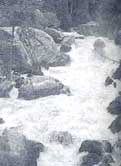Rivers from Himalayan major uranium source
 THE HIMALAYAN-Tibetan rivers have been found to be a major source of marine uranium and scientists estimate they contribute about 3,000 tonnes, or, about 25 per cent of the total, worldwide marine uranium. The Ganga and the Brahmaputra together, they estimate, dump about 1,000 tonnes of dissolved uranium annually in the estuaries of the Bay of Bengal.
THE HIMALAYAN-Tibetan rivers have been found to be a major source of marine uranium and scientists estimate they contribute about 3,000 tonnes, or, about 25 per cent of the total, worldwide marine uranium. The Ganga and the Brahmaputra together, they estimate, dump about 1,000 tonnes of dissolved uranium annually in the estuaries of the Bay of Bengal.
M M Saini, S Krishnaswami and J R Trivedi, of the Physical Research Laboratory in Ahmedabad, and K K Sharma, of the Wadia Institute of Himalayan Geology in Dehra Dun, estimate that the amount of uranium in the Himalayan streams as a proportion of the area drained by them, is about 100 times that of the Amazon and the Congo (Current Science, Vol. 62, No. 12).
Research on the uranium content of the Alaknanda and Bhagirathi rivers indicates the high uranium load is a result of intense chemical weathering of the Himalayas. The range of uranium concentration in the Bhagirathi and its tributaries is between 0.15-3.96 micrograms per litre and averages about 2 micrograms per litre, which is about the same as the concentration in the lower reaches of the Ganga.
Weathering of certain granites in the upper reaches of the Bhagirathi and of some mineral zones in its drainage basin are said to be responsible for the high uranium content. Studies of coral indicate uranium weathering via the Himalayan-Tibetan rivers may be responsible for a part of the 30 per cent increase in marine uranium since the Miocene period 24 million years ago.
